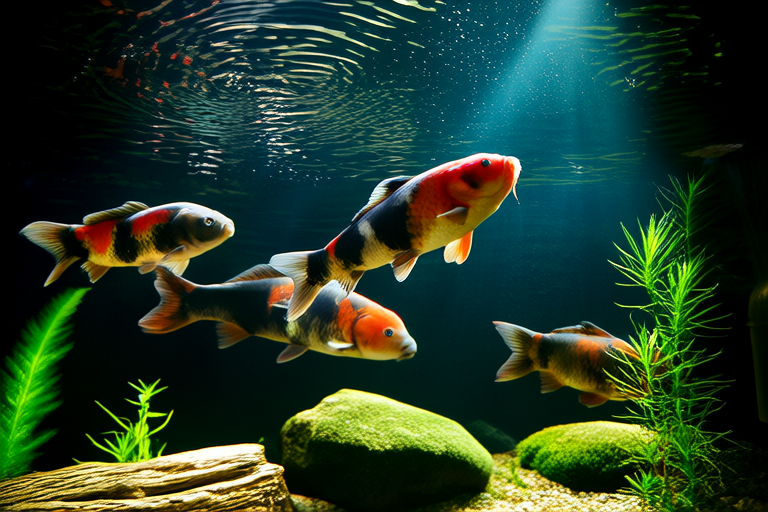
Mastering Koi Care: Tips for Thriving Water Gardens
Koi fish, known for their vibrant colors and graceful movements, have captivated aquarists and garden enthusiasts alike. These ornamental carp are descendants of common carp, selectively bred over centuries to display stunning patterns and hues. Their popularity in water gardens stems from their aesthetic appeal and the tranquility they bring to outdoor spaces. Koi are not just beautiful; they are intelligent creatures that can live for decades, making them a long-term commitment for any gardener.
Setting Up a Healthy Aquatic Environment
To ensure your koi thrive, it’s crucial to establish a healthy aquatic environment. This involves maintaining optimal water quality, employing effective filtration systems, and ensuring adequate oxygen levels.
Water Quality
Water quality is paramount for koi health. Ammonia, nitrite, and nitrate levels must be kept at safe levels. Regular testing using aquarium test kits is recommended. High ammonia levels can be lethal to koi, while nitrites can cause stress and reduce their ability to absorb oxygen. Nitrate, though less harmful, should also be monitored and kept low to prevent algae blooms.
Filtration Systems
A robust filtration system is essential for removing waste, excess food, and toxins from the water. Mechanical filters trap debris, biological filters convert harmful ammonia into less toxic substances, and chemical filters help control water chemistry. A combination of these ensures a clean and healthy environment for your koi.
Oxygen Levels
Proper oxygenation is vital for koi survival. Oxygen levels can drop during hot weather or when water becomes stagnant. Incorporating waterfalls, fountains, or aerators helps increase oxygen levels. Additionally, ensure that your pond has enough surface area exposed to air to facilitate gas exchange.
Feeding Practices
Feeding koi appropriately is key to their well-being. Nutritional balance and portion control are critical aspects of koi care.
Nutrition
Choose high-quality koi food that provides a balanced diet. Foods should include proteins, fats, carbohydrates, vitamins, and minerals. Look for products specifically formulated for koi, which cater to their nutritional needs. Seasonal changes affect feeding requirements; adjust the type and amount of food accordingly. In colder months, koi metabolism slows, so reduce feedings and opt for lower-protein foods.
Portion Control
Overfeeding can lead to poor water quality and obesity. Feed koi small portions several times a day rather than one large meal. Allow the koi to finish eating within five minutes; if they are still hungry, provide more food. Uneaten food should be removed promptly to avoid polluting the water.
Maintaining Water Temperature
Temperature fluctuations can stress koi and affect their immune systems. In warmer climates, shade the pond to prevent overheating. In cooler regions, consider heating systems or deepening the pond to maintain stable temperatures. Aim for a consistent range between 64°F and 77°F (18°C to 25°C).
Managing Common Health Issues
Early detection and treatment of health issues are crucial for koi longevity. Monitor for signs of illness such as lethargy, loss of appetite, abnormal swimming behavior, or visible lesions. Common ailments include fin rot, fungal infections, and parasitic infestations. Consult a veterinarian specializing in fish for diagnosis and treatment.
Selecting Suitable Plants
Integrating plants into your water garden not only enhances its beauty but also supports the ecosystem. Plants like water lilies and lotus provide shade, reduce algae growth, and offer hiding spots for koi. Submerged plants, such as hornwort and anacharis, improve water quality by absorbing nutrients and producing oxygen. Floating plants, like water lettuce and duckweed, help control algae by blocking sunlight.
Regular Maintenance and Observation
Consistent maintenance and vigilant observation are vital for sustaining a thriving water garden.
Maintenance Tasks
Regularly clean filters and skimmers, remove debris, and perform partial water changes to maintain water quality. Inspect equipment for wear and tear and replace parts as necessary. Prune plants to keep them healthy and aesthetically pleasing.
Observation
Regularly observe your koi for any signs of distress or unusual behavior. Early detection of problems can prevent further complications. Keep a journal to track water parameters, feeding schedules, and any health issues. This documentation can be invaluable for diagnosing problems and adjusting care routines.
In conclusion, mastering koi care requires attention to detail and a commitment to providing a nurturing environment. By understanding and addressing the essential factors discussed, you can enjoy the beauty and serenity that koi bring to your water garden. Whether you’re a beginner or an experienced hobbyist, these tips will help ensure your koi live long, healthy lives.






